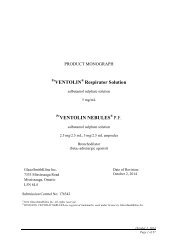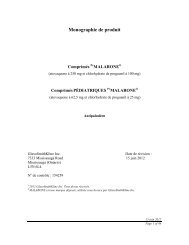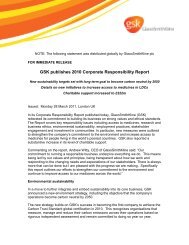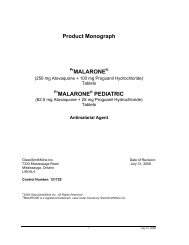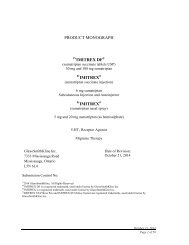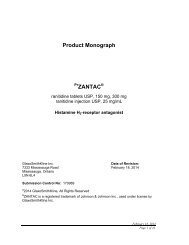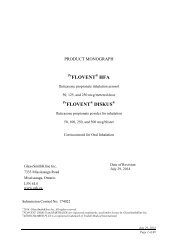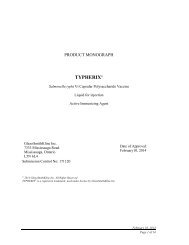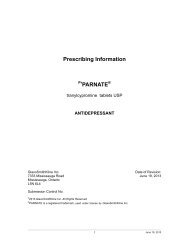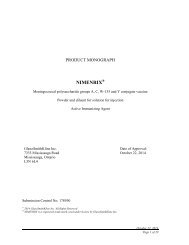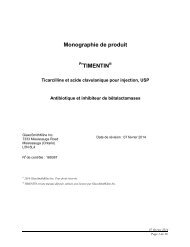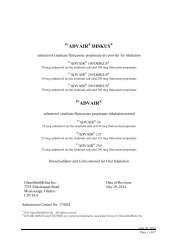Ventolin Diskus - GlaxoSmithKline
Ventolin Diskus - GlaxoSmithKline
Ventolin Diskus - GlaxoSmithKline
Create successful ePaper yourself
Turn your PDF publications into a flip-book with our unique Google optimized e-Paper software.
Salbutamol was given to dogs twice daily, in oral doses from 0.05 to 12.5 mg/kg, on anincreasing scale. The rate of increase of hemoglobin and packed cell volume wasdepressed, particularly at higher doses. Leukocyte count decreased after sixteen weeks oftreatment at each dose level. Platelet count was increased after eight weeks at the highestdose. No significant biochemical effects were observed. The only significant histologicalchange was the appearance of corpora amylacea in the stomach which was attributed toaltered mucus secretion. Inhalation of 1000 mcg of salbutamol aerosol twice daily forthree months did not produce any morphological changes in the lungs, trachea, lymphnodes, liver or heart.Long-Term ToxicityFifty female, Charles River CD Albino rats received salbutamol orally at 2, 10 and50 mg/kg/day for one hundred and four weeks; fifty female Charles River CD Sprague-Dawley-derived rats received 20 mg/kg/day salbutamol orally for fifty weeks, and fiftyfemale Charles River Long-Evans rats received 20 mg/kg/day salbutamol orally forninety-six weeks. These rat studies demonstrated a dose-related incidence of mesovarianleiomyomas. No similar tumors were seen in mice.MutagenicityIn vitro tests involving four micro-organisms revealed no mutagenic activity.CarcinogenicityIn a two-year study in the rat, salbutamol sulphate caused a significant dose-relatedincrease in the incidence of benign leiomyomas of the mesovarium at dosescorresponding to 111, 555, and 2,800 times the maximum human inhalation dose. Inanother study, the effect was blocked by the co-administration of propranolol. Therelevance of these findings to humans is not known. An 18-month study in mice and alifetime study in hamsters revealed no evidence of tumorigenicity.Teratogenicity StudiesSalbutamol has been shown to be teratogenic in mice when given in doses correspondingto 14 times the human aerosol dose; when given subcutaneously in doses correspondingto 0.2 times the maximum human (child weighing 21 kg) oral dose; and when givensubcutaneously in doses corresponding to 0.4 times the maximum human oral dose.A reproduction study in CD-1 mice given salbutamol at doses of 0.025, 0.25, and2.5 mg/kg subcutaneously, corresponding to 1.4, 14, and 140 times the maximum humanaerosol dose respectively, showed cleft palate formation in 5 of 111 (4.5%) fetuses at0.25 mg/kg and in 10 of 108 (9.3%) fetuses at 2.5mg/kg. No cleft palates were observedat a dose of 0.025 mg/kg salbutamol. Cleft palate occurred in 22 of 72 (30.5%) fetusestreated with 2.5 mg/kg isoprenaline (positive control).In rats, salbutamol treatment given orally at 0.5. 2.32, 10.75 and 50 mg/kg/daythroughout pregnancy resulted in no significant fetal abnormalities. However, at thehighest dose level there was an increase in neonatal mortality. Reproduction studies inrats revealed no evidence of impaired fertility.October 03, 2007Page 18 of 23



